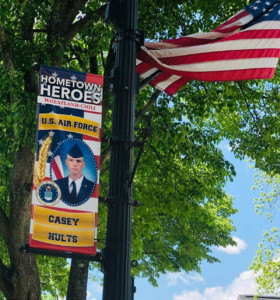
Could Stonewall Jackson Johnson have paid a visit to his former home? Photo taken by Jessica Samluk, August 19, 2017.
BY JENNIFER CROWLEY
Though Stonewall Jackson Johnson died nearly seventy years ago, his legacy lives on through Scottsville’s Johnson Park. Basketball, baseball, and soccer games … summer evenings at the playground… frog catching in the creek… recreation camp arts and crafts … these experiences wouldn’t be possible without the generosity and vision of Johnson.
Johnson was born to slave parents on February 2nd, 1863 in Culpeper, Virginia. Luckily for Johnson the Civil War ended when he was just a toddler. Emancipated, his family eventually moved north to Western New York since several others from the Culpeper area had settled here after the war.
As an adolescent Johnson attended school in Scottsville. He went on to marry Charlotte Beasley and the couple would welcome five children into the world. They lived in a house on the land which today is formally named Johnson Park.
The late Rochester newspaper columnist Henry Clune, who also lived in Scottsville and knew Johnson, wrote about the affable farmer shortly after his passing. Clune described Johnson as, “Small of stature, but singularly strong and wiry.” This is fitting since Johnson had a passion for working the land – even just using his bare hands.*

An undated photo of Stonewall Jackson Johnson from a printed book. Photo courtesy of Kevin Allen.
Given a considerable green thumb, Johnson’s home became known for its stunning gardens. In fact he developed a three-acre private park on his property in 1934. The park became a destination for group picnics and activities, much like it is today. According to Clune’s writings, “Each Summer he turned his land into a garden, with many kinds of flowers and the neatest and most prolific vegetable patch in town. The rustic beauty of the place gave it the name ‘Johnson Park,’ and the men from the Legion Post sometimes held their outings there.”
The Johnson Park of the mid-20th century had a pond for fishing and courts for both horseshow and croquet. In the winter Johnson would flood an area for ice skating. The Park became a favorite spot for neighbors and their children to gather and enjoy socializing along with leisure activities.
Johnson died in November 1950 at the age of 86. His obituary paid tribute to the man who brought so much joy to local children. The piece also mentioned that one of Johnson’s favorite annual events was “Negro Emancipation Day,” held at his park. The celebration was common in cities and towns though it did not have a universal date. In the 1920s, “Negro History Week” emerged and was celebrated in mid-February since both Abraham Lincoln and Frederick Douglass both had birthdays then. In 1970, Black History Month was dedicated through efforts by black students attending Kent State University. Six years later President Gerald Ford publicly acknowledged the observation during events related to America’s bicentennial.
After Johnson’s death, the Village of Scottsville acquired the property from his family after agreeing that the land would retain its Johnson Park name and mission.
According to Kevin Allen, a lifetime resident of Scottsville who spent considerable time researching Johnson, a part of Johnson’s home still stands in the park. A piece of the foundation is visible behind the fenced-in baseball diamond. Allen became interested in the life of Johnson after seeing a photo taken at the park’s 2017 car show. Allen and his father Freddie have organized the annual car show on the grounds of Johnson Park for the past several years. “I was looking at pictures on social media from the event and zoomed in to look at one of my cars when I noticed the faint image of a man. He seemed transparent and dressed in warm clothes when it was a very hot day. Most people who saw it agreed it certainly looked like a ghost,” Allen explained.
From here Allen contacted Genesee Valley Paranormal Investigators who investigated the case and concluded it was likely Johnson. “This man was a total class act. We learned he lost two children at fairly young ages and just dedicated himself to local kids after that.” Allen added that it would make sense Johnson would pay a visit to his former home on such a busy day given how much he enjoyed the land and bringing others happiness through his hard work.
A plaque hanging in the Park’s pavilion building describes Johnson’s life through words and photos. Anyone interested in renting Johnson Park for a private event should contact the Village of Scottsville at www.scottsvilleny.org for availability and cost.
*From Henry W. Clune’s “Seen and Heard” column, November 14, 1950 published in the Rochester Democrat & Chronicle.







